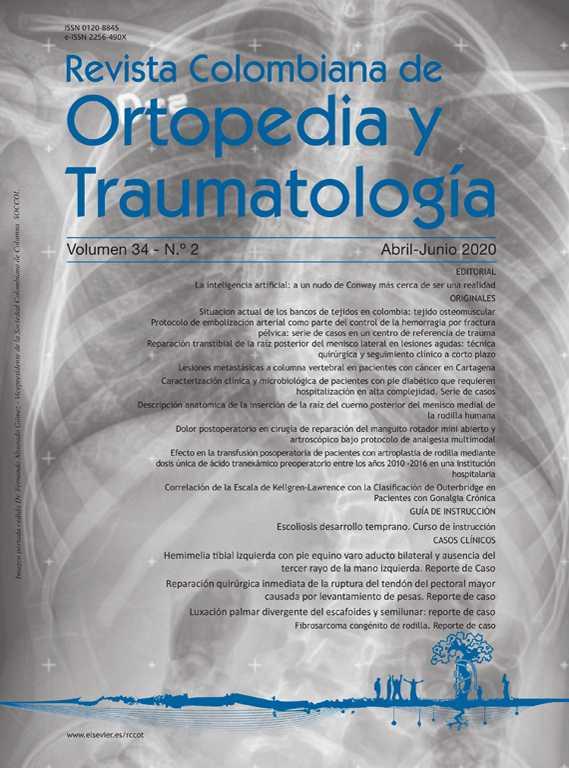Left tibial hemimelia with bilateral clubfoot and absence of the third ray of the left hand. Case Report
DOI:
https://doi.org/10.1016/j.rccot.2020.06.008Keywords:
bone, developmental anomaly, tibial hemimelia, clubfootAbstract
Tibial hemimelia is a broad spectrum disorder, from tibial hypoplasia to complete absence of the tibia with or without quadricipital, ligament, patellar, fibular and / or femoral attachment. This has led to multiple classifications, with their anatomical and therapeutic implications. Although this disorder has been described since 1841, it is the rarest deficiency in the lower extremities, with the most common being fibular deficiency.
The case is presented on a patient with an antenatal diagnosis that included bilateral congenital talipes equinovarus, agenesis of the left tibia, and atrioventricular communication with normal karyotype. The facies were normal at birth. Radiographs confirmed the absence of the third ray of the left hand and the absence of the left tibia, with widening of the fibula, type 5C in Paley classification, and bilateral congenital talipes equinovarus.
Evidence Level: IV
Downloads
References
Clinton R, Birch JG. Congenital Tibial Deficiency: A 37-Year Experience at 1 Institution. J Pediatr Orthop. 2015;35:385-90. https://doi.org/10.1097/BPO.0000000000000280
Paley D. Tibial hemimelia: new classification and reconstructive options. J Child Orthop. 2016;10:529-55. https://doi.org/10.1007/s11832-016-0785-x
Weber M, Schröder S, Berdel P, et al. Register zur bundesweiten Erfassung angeborener Gliedmaßenfehlbildungen [Database for the nationwide collection of congenital limb malformations]. Z Orthop. 2005;143:1-5. https://doi.org/10.1055/s-2005-872467
Chinnakkannan S, et al. A case of bilateral tibial hemimelia type VIIa Indian Journal of Human Genetics. 2013:108-10. https://doi.org/10.4103/0971-6866.112924
Jayakumar SS, Eilert RE. Fibular transfer for congenital absence of the tibia. Clin Orthop Res. 1979;139:97-101. https://doi.org/10.1097/00003086-197903000-00016
Sowinska-Seidler' A, Socha M, Jamsheer A. Split-hand/foot malformation - molecular cause and implications in genetic counseling. J Appl Genet. 2014;55:105-15. https://doi.org/10.1007/s13353-013-0178-5
Hesselschwerdt HJ1, Heisel J. Mesomelic dysplasia: presentation of a case and literature of Werner's syndrome. Z Orthop Ihre Grenzgeb. 1990;128:466-72. https://doi.org/10.1055/s-2008-1039598
Wiedemann HR, Opitz JM:. Unilateral partial tibia defect with preaxial polydactyly, general micromelia polydactylyandtrigonomacrocephaly with a note on "developmental resistance". Am J Med Genet. 1983;14:467-72. https://doi.org/10.1002/ajmg.1320140310
Carvalho DR1, Santos SC, Oliveira MD, Speck-Martins CE. Tibial hemimelia in Langer-Giedion syndrome with 8q23.1-q24 12 interstitial deletion. Am J. Med Genet A. 2011;155A:2784-7. https://doi.org/10.1002/ajmg.a.34233
Richieri-Costa A, Ferrareto I, Masiero D, et al. Tibial hemimelia: report on 37 new cases, clinical and genetic considerations. Am J Med Genet. 1987;27:867-84. https://doi.org/10.1002/ajmg.1320270414
McKay M, Clarren SK, Zorn R. Isolated tibial hemimelia in sibs: an autosomal-recessive disorder? Am J Med Genet. 1984;17: 603-7. https://doi.org/10.1002/ajmg.1320170308
Deimling S, Sotiropoulos C, Lau K, et al. Tibial hemimelia associated with GLI3 truncation. J Hum Genet. 2016;61:443-6. https://doi.org/10.1038/jhg.2015.161
McCredie J, Willert HG. Longitudinal limb deficiencies and the sclerotomes An analysis of 378 dysmelic malformations induced by thalidomide. J Bone Joint Surg (Br). 1999;81:9-23. https://doi.org/10.1302/0301-620X.81B1.0810009
American Institute of Ultrasound in Medicine. AIUM Practice Guideline for the Performance of an Antepartum Obstetric Ultrasound Examination. Laurel, MD: American Institute of Ultrasound in Medicine; 2003.
Goldstein I, Lockwood C, Belanger K, Hobbins J. Ultrasonographic assessment of gestational age with the distal femoral and proximal tibial ossification centers in the third trimester. American Journal of Obstetrics and Gynecology. 1988;158:127-30, http://dx.doi.org/10.1016/0002-9378(88)90793-4. https://doi.org/10.1016/0002-9378(88)90793-4
Serman LS, Potter SS, Scott WJ. En: Larsen WJ, editor. Human embryology. 3rd ed New York: Churchill Livingstone; 2002. p. 315-28.
Jones D, Barnes J, Lloyd-Roberts GC. Congenital aplasia and dysplasia of the tibia with intact fibula: classification and management. J Bone Joint Surg (Br). 1978;60:31-9. https://doi.org/10.1302/0301-620X.60B1.627576
Weber M. New classification and score for tibial hemimelia. J Child Orthop. 2008;2:169-75, http://dx.doi. org/10.1007/s11832-008-0081-5. https://doi.org/10.1007/s11832-008-0081-5
Paley D, Chong DY Tibial hemimelia. In: Sabharwal S (1ed) Pediatric lower limb deformities: principles and techniques of management. Springer, Switzerland, pp 455-481. https://doi.org/10.1007/978-3-319-17097-8_24
Granite G, Herzenberg JE, Wade R. Rare case of tibial hemimelia, preaxial polydactyly, and club foot. World J Clin Cases. 2016;4:401-8. https://doi.org/10.12998/wjcc.v4.i12.401
Al Kaissi A, Ganger R, Rötzer KM, Klaushofer K, Grill F. A child with split-hand/foot associated with tibial hemimelia (SHFLD syndrome) and thrombocytopenia maps chromosome region 17p13.3. Am J Med Genet A. 2014;164A:2338-43, 10.1002/ajmg.a. 4 3661. https://doi.org/10.1002/ajmg.a.36614
Spiegel DA, Loder RT, Crandall RC. Congenital longitudinal deficiency of the tibia. Int Orthop. 2003;27:338-42. https://doi.org/10.1007/s00264-003-0490-5





